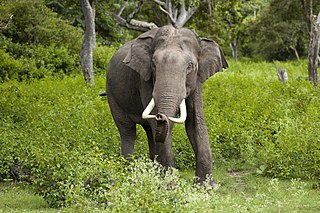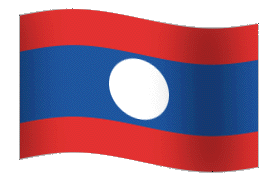 W
WThe Asian elephant, also known as the Asiatic elephant, is the only living species of the genus Elephas and is distributed throughout the Indian subcontinent and Southeast Asia, from India in the west, Nepal in the north, Sumatra in the south, and to Borneo in the east. Three subspecies are recognised—E. m. maximus from Sri Lanka, E. m. indicus from mainland Asia and E. m. sumatranus from the island of Sumatra.
 W
WThe National Emblem of the Lao People's Democratic Republic shows the national shrine Pha That Luang. A dam is pictured which as a symbol of power generation at the reservoir Nam Ngum. An asphalt street is also pictured, as well as a stylized watered field.
 W
WThe flag of Laos consists of three horizontal stripes, with the middle stripe in blue being twice the height of the top and bottom red stripes. In the middle is a white disc, the diameter of the disc is 4⁄5 the height of the blue stripe. The flag ratio is 2:3.
 W
WThe hammer and sickle is a symbol meant to represent proletarian solidarity – a union between the peasantry and the working class. It was first adopted during the Russian Revolution, the hammer representing workers and the sickle representing the farmers.
 W
WThe following is a flag list of Laos.
 W
WPha That Luang is a gold-covered large Buddhist stupa in the centre of the city of Vientiane, Laos. Since its initial establishment, suggested to be in the 3rd century AD, the stupa has undergone several reconstructions as recently as the 1930s due to foreign invasions of the area. It is generally regarded as the most important national monument in Laos and a national symbol.
 W
W"Pheng Sat Lāo" is the national anthem of the Lao People's Democratic Republic. Dr. Thongdy Sounthonevichit composed the music and wrote the lyrics in 1941. It was adopted as the national anthem of the Kingdom of Laos in 1945. The original lyrics were revised after the Communists triumphed in the Laotian Civil War and established the Lao People's Democratic Republic in 1975, with the new lyrics written by Sisana Sisane.
 W
W